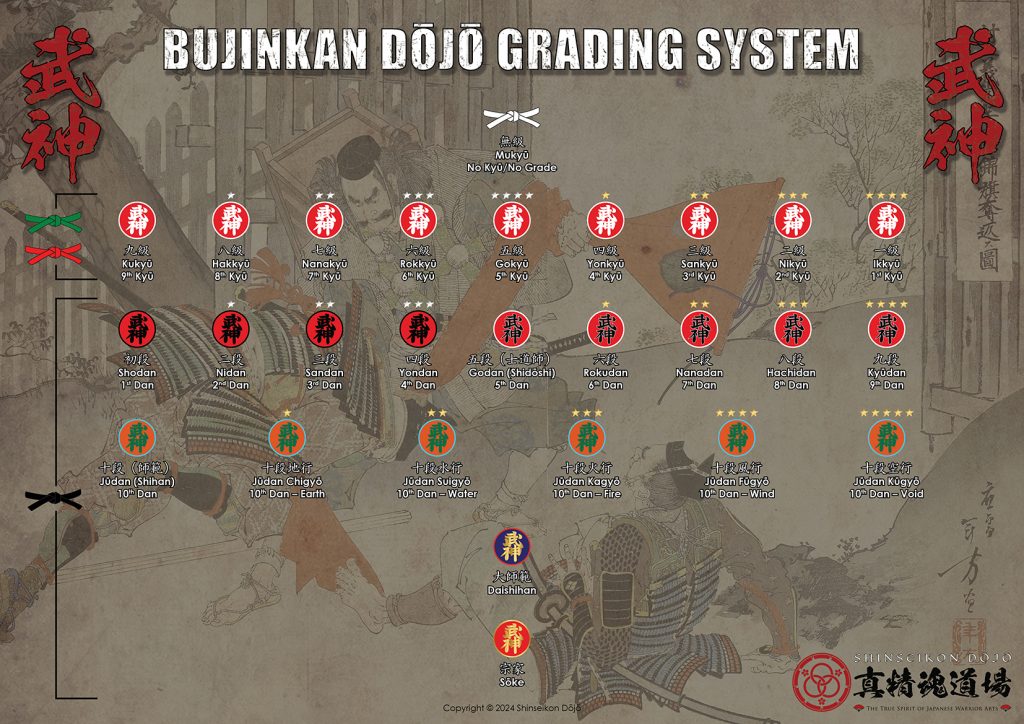The Grade System

Most ryûha of kobujutsu do not employ the modern-day ranking system of kyû and dan grades, and associated belt colours or other ways of visibly recognising rank (a system originally invented by Kanô Jigorô, the founder of jûdô), and instead employ what is known as the “menkyo system”, which consists of recognising “mastery” of different levels once a person has achieved a certain skill-level and then typically receives copies of the densho (written transmissions) of the ryûha. This was also the case with the nine ryûha of which the Bujinkan is comprised when Takamatsu-sensei taught Hatsumi-sensei. However, for the sake of practicality, Hatsumi-sensei eventually adopted the modern-day grading system for the Bujinkan Dôjô organisation, but rather than relying on numerous belt colours, grades are chiefly identified by means of certain specific “wappen” (embroidered patches) worn on the chest, and with silver or gold stars positioned above.
THE TECHNICAL PART
In the Bujinkan, the grading system begins with mukyû, which literally means “no kyû”, or no grade, and is for the new student who has yet to be officially graded and awarded the appropriate certificate issued by the Bujinkan Honbu (Headquarter) Dôjô in Japan. This position as a beginning student of Bujinkan Budô is identified by a shiro obi (white belt) and no wappen, or patch. The first official grade is that of kukyû (9th kyû), which then proceeds downwards, with ikkyû (1st kyû) being the highest. These kyû grades are identified by the introduction of the first wappen and two belt colours: green for men and red for women; though some dôjô today have chosen to simply use green for both men and women of kyû grades. The individual kyû grades are then marked by the numbers of silver and gold stars illustrated in the image above.
Some dôjô in the organisation are a bit more liberal about the wearing of patches and stars and therefore might only wear some of this paraphernalia, or even none of it, with the sole exception of the coloured belts. This varies from teacher to teacher and dôjô to dôjô. We at Shinseikon Dôjô, however—without criticising or casting any judgement on any fellow practitioners of Bujinkan Budô—are traditionalists and therefore insist on the wearing of proper attire in terms of belts in the stated colours along with the correct patches (and only the official patches issued by Honbu in Japan). As for the stars, we allow ourselves to be a bit more “flexible”, simply out of necessity as they can be somewhat finicky. Though we try to be as diligent as we can about wearing them whenever possible.
From first kyû, it then moves into the dan grades, which are marked by a black belt and then various wappen/patches along with silver/gold stars, according to the given grade or instructor level. Once a Bujinkan Budô practitioner attains godan (5th dan), he/she becomes eligible to open a dôjô and teach on his/her own, and thus is granted the title of “shidôshi”—a term employed in the Bujinkan Dôjô organisation for a teacher/an instructor. Later, when attaining the highest grade in the organisation, that of jûdan (10th dan), one is awarded the title of “Shihan”, carrying the connotation of a master instructor, or senior instructor.
Although 10th dan is technically the highest numerical grade in the Bujinkan, there are five grades of “master levels” above that known as the “elemental levels”: Chigyô, Suigyô, Kagyô, Fûgyô and Kûgyô—Earth, Water, Fire, Wind and Void (Emptiness). Though for the sake of convenience, these are often referred to as 11th, 12th, 13th, 14th and 15th dan. That is, however, a bit of a misnomer, but it does make the understanding of them somewhat simpler, in a way.
A few years ago, the system of “Daishihan”, or “Great Shihan”, was introduced to help govern and manage the organisation, due to some restructuring in terms of administration. Whereas teachers and students in the past acquired annual membership cards directly from Honbu Dôjô via their teacher, this has now been abolished and the individual instructors running their own dôjô all affiliate to a daishihan, either through location or personal acquaintance. How this is managed by the individual daishihan varies and it is the right of each to do it as he/she deems best. Some like to still maintain the “old school” system of annual membership cards, which in that case, then, is simply in relation to that daishihan and/or his or her dôjô rather than to Honbu Dôjô in Japan.
THE IMPORTANT PART
After having covered all this technical information, what really matters with regard to grades or “ranks”, is not the colour of the belt, the style of wappen (patch), the number of stars or the lofty titles, but the knowledge, skill and development attained through study, practice, dedication and hard work. For advancement in grades, we value skill and development over matters such as time spent in the dôjô and/or seniority within the art itself. As such, there is no “guarantee” for when someone will receive the next grade; and there is no such thing as “attaining black belt in 2 years”, as is the case in some martial arts. It all depends on the student, the training and the dedication to learning, which then manifests in the form of development of skill, understanding and maturity. These are the factors that determine when and how people will move upward in terms of grades; but far more importantly is to forget about such matters and rather focus on simply learning, improving, increasing in knowledge, understanding, wisdom, and by means of all this developing as a warrior of the old Japanese martial ways and as a person. Grades or ranks are not important at all! They are but a means for teachers to know what they can expect of a student in terms of skill and ability, and thus at what level they can train.